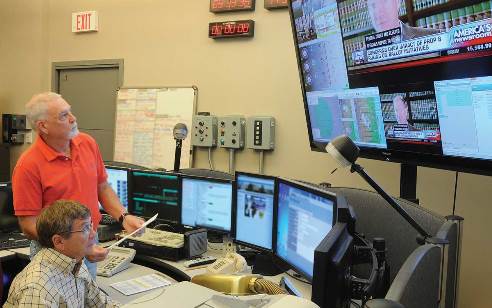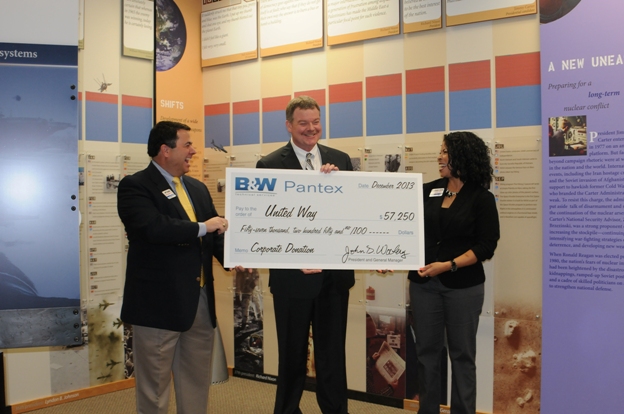Pantex Blog
Pantex Behind the Scenes: Operations and Emergency Services Dispatch Centers

Robert Inglis and Forrest McLaughlin (seated) review incoming information at the Operations Center, the 24-hour base often referred to as the Heart of Pantex.
“May I have your attention please?” The room instantly grows quiet as Pantexan listen to the familiar voices for directions, notifications or warnings. The Operations Center (OC) is what some may call the Heart of Pantex. It is responsible for 24-hour management of operations to ensure the overall safety and efficiency of the Pantex Plant.
Established under the Department of Energy’s (DOE) Occurrence Reporting Program in 1990, the OC strives to provide information to the appropriate publics in a timely manner. The Center began operations in a small conference room with few supplies. The need for more equipment and space quickly became obvious. Soon after, operations moved to the building where they remain today.
With 12 years of experience at the Plant, Matt Eberly recently accepted the position as Emergency Services Group manager, which encompasses both Fire and Emergency Management Departments. “The work is extremely important because both the OC and Emergency Services Dispatch Center (ESDC) programs require prompt, safe and reliable action 24/7 to support Plant operations and our surrounding communities,” said Eberly.
“The ESDC and OC teams are required to operate in an environment where precision and effectiveness are critical. They essentially work in the nerve center of all Plant operations.”
The OC consists of nine employees, each with at least 30 years of experience at the Plant. Eight of them are Plant shift superintendents, while Bill Ornelas is Pantex’s Move Right specialist. The OC is responsible for a number of operations, such as weather notification activities, movement of materials and initiation of protective actions for Plant personnel.
Randy Nuttall, who started in the Maintenance Department, enjoys working in the OC because of the diversity within the job. “Every day is different. You never know what the call is going to bring. And it helps that I work with the best group of people,” said Nuttall.
 At the Plant's Emergency Dispatch Center, Dorcas Gaddis and Melodi Parton (seated) monitor fire alarms from the Center's testing console.
At the Plant's Emergency Dispatch Center, Dorcas Gaddis and Melodi Parton (seated) monitor fire alarms from the Center's testing console.
Across the hall from the OC is the ESDC. Similar to the OC, it houses nine employees working side-by-side. The ESDC is responsible for testing fire alarms throughout the Plant, assisting surrounding counties with emergency calls and for medical and fire emergencies on Plant site.
When the ESDC first started operations in 2006, Don Rhoades, a Pantex veteran, transferred with over 29 years of experience in security. He said the transition was easy and normal, and he enjoys where he is working now. “I love the job itself. Our main goal is to protect life and property, and when I go home at night, I feel a sense of accomplishment knowing that I helped people that day,” said Rhoades.
His colleagues, Dorcas Gaddis and Steve McWilliams both agree that communication is what makes them successful. McWilliams explained that the job comes with great pride in knowing potential lives are saved each day.
Lubbock High Wins High School Science Bowl
Team to represent region at National Science Bowl

After nearly 12 hours of grueling intellectual competition Saturday, a team from Lubbock (Texas) High School edged out the team from Amarillo High School to take top honors at the Pantex High School Science Bowl competition. The Lubbock High team will represent the region at the National Science Bowl in April.
More than 30 teams gathered at West Texas A&M University to test their knowledge of science and math, and to battle it out for a trip to the national competition in Washington D.C.
The Amarillo High team – made up of three sophomores and one freshman – had an excellent competition, moving into the finals without a single loss. The Lubbock High team had to beat another Lubbock team to move into the finals, then beat Amarillo twice for victory in the double elimination competition.
The Lubbock team will be joined at nationals by a team from Panhandle Junior High, which won the middle school competition two weeks ago. Pantex has sponsored the Science Bowl competition in the Amarillo area for 23 years.

Dignitaries Make Mark on Pantex Renewable Energy Project
U.S. Congressman Mac Thornberry joined local dignitaries and other visitors gathered at the Pantex Plant Thursday to make their mark on an important wind project at the Plant. The visitors joined NNSA Production Office and B&W Pantex leaders, as well as representatives from project contractor Siemens Government Technologies Inc., in signing one of the massive wind turbine blades that will become part of the Pantex Renewable Energy Project (PREP). When it is complete this spring, PREP will be the largest federally owned wind farm in the U.S. and will provide more than 60 percent of the annual electricity needs for the Plant.
The ceremony provided stakeholders an opportunity to receive an update on the project, as well as get a close-up look at the wind turbines that make up the project. Each blade weights 11 tons and is more than 150 feet long. When completed, the towers will stand over 400 feet tall at the blade tips.
Elected officials visiting the Plant included Thornberry, Texas State Sen. Kel Seliger, Texas State Legislator Four Price, Amarillo Mayor Paul Harpole and Carson County Judge Lewis Powers.
B&W Pantex Makes Donation to United Way

B&W Pantex General Manager John Woolery, center, presents a B&W corporate donation Friday to the United Way of Amarillo and Canyon. United Way Interim Executive Director Jeff Gulde, left, and Campaign Director Stephanie Goins were on hand to receive the gift.
The $57,250 corporate donation supplements more than $650,000 pledged by Pantex employees to United Way for 2013, making Pantex one of the largest supporters of United Way in the Texas Panhandle. Woolery recognized that Pantexans “have big hearts” and are proud to give back to their communities.
First Blade Delivered to Pantex Renewable Energy Project

The first wind turbine blade is delivered to the site of the Pantex Renewable Energy Project Thursday. Work crews are beginning to erect the first of five wind turbines that will make up the PREP project. When it is completed this spring, PREP will be the largest federally owned wind farm in the country and will provide approximately 60 percent of the average annual electricity need for the Pantex Plant.
